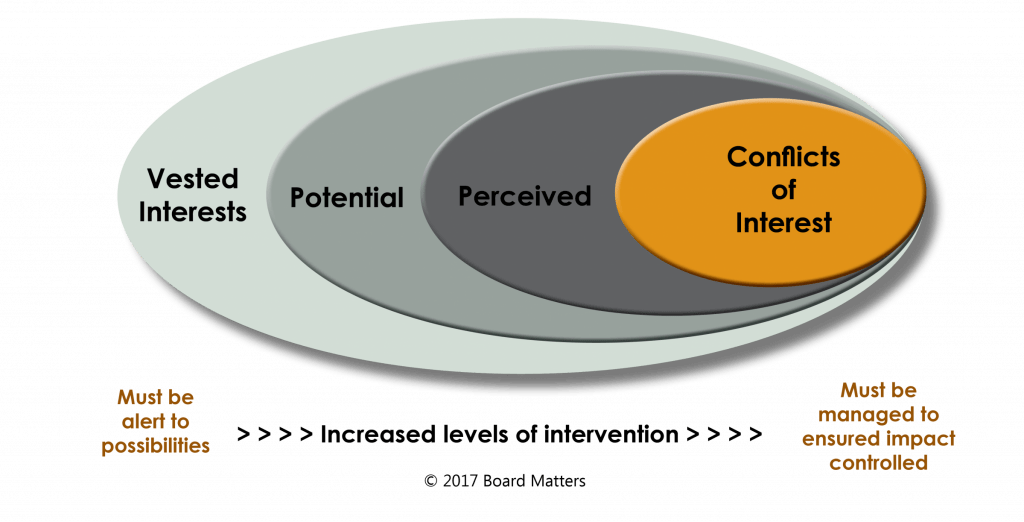Let’s get one thing straight: it is a very good thing for directors – all directors – to come to the board table with healthy vested interests in the decisions of the organisation being ‘right’. The flip side of that coin is the healthy vested interest that becomes an unhealthy conflict of interest when the director’s view of what is the ‘right’ decision is more influenced by other interests or duties they have than by the interests of the organisation.
Poorly managed conflicts of interest in the boardroom can cast long shadows. They can inflict lasting damage on the dynamic and operation of the board. For as long as boards are made up of people they are likely to continue to be one of the most common sources of boardroom tension and yet are still amongst the least well understood.
Most directors and executives have a good grasp of the fundamentals of conflict of interest and will adopt all of the well known prescriptions of contemporary corporate governance practice (a clear and consistent board policy on the optic, annual declarations, standing item on the agenda, discussion and decisions in absence of the conflicted director etc). But the trouble is rarely in the application of those prescriptions.
The trouble with conflicts of interest is, rather, in agreeing whether there is one. It is easy to see them in others – even when they aren’t there. It is well night impossible to see them in ourselves (The “I am perfectly capable of handling my own conflicts” syndrome).
It is important, however, for boards to learn to better distinguish between healthy vested interests amongst directors and vested interests that have become conflicts of interest. And everything else in between.

On this spectrum, moving from right to left:
- Actual conflicts of interest – being competing interests or duties to other organisations (including as a board member elsewhere) that are likely to influence a director in relation to a decision before the board. These types of conflicts must be dealt with consistently and in accordance with a legally compliant and carefully developed conflict of interest management policy as anticipated above.
- Potential conflict of interest – in which it is likely because of the particular vested interests of the director that certain decisions expected to be made in the future will present actual conflicts of interest. These potential conflicts of interest should be managed carefully to ensure that the relevant director is continually aware of the possibility of a potential conflict of interest becoming an actual conflict of interest and takes an approach of open declaration and management of the interests without assuming that other directors have a deep understanding of their potential conflicts of interest.
- Perceived conflicts of interest – whilst by definition the expression ‘perceived’ conflict of interest implies that a person does not have an ‘actual’ conflict of interest at law, perception is reality for many. Stakeholder perceptions that a director has or may have an actual or potential conflict of interest should be treated with as much seriousness as actual or potential conflicts of interest. This, again, suggests that boards should freely and openly discuss each others’ actual, potential and perceived conflicts of interest for the good of the organisation.
- Vested interests – these are the healthy motivating reasons why directors join boards. It may be because of a longstanding passion and/or experience in a certain industry or sector, a personal business in a related field or simply an interest in being a professional, paid, portfolio non-executive director on the boards of good and successful organisations. These are the interests that keep motivating directors year after year to read copious board papers and contribute an exceptional number of hours to the endeavours of the board. By definition the vested interests of all directors – at least all dedicated and useful directors – can be at risk of presenting potential, perceived or actual conflicts of interest.
The checklist
So, when your board is struggling to deal with a seeming conflict of interest within the board ask:
- Is this truly a ‘conflict of interest’ meaning that the directors conflicting interests or duties elsewhere are likely to impact on their ability to do their job in relation to particular decisions of this board?
- Is it, rather, a case of concern about perceptions or the possibility that it may become a conflict of interest?
- Irrespective of how we classify it, what are the perceived or potential consequences of the situation that are of concern to the directors (including the director with the seeming conflict)?
- What are the practices we can put in place to deal with the conflict in question?
- Should the treatment be different based on what type of ‘conflict’ we decide it is and the potential consequences that we have identified?
- Does our conflict of interest policy (and practices) adequately deal with differentiating between these different types of conflicts and how we should respond to them?
Elizabeth Jameson